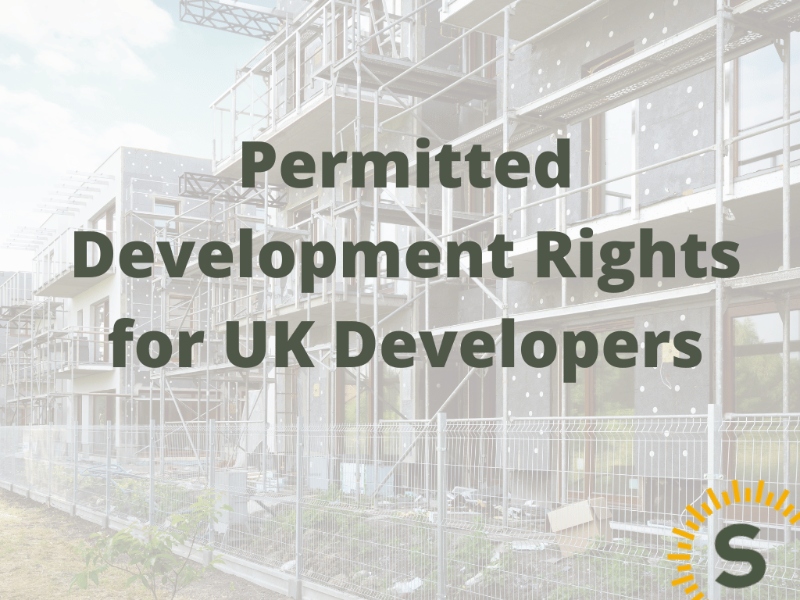
In the ever-evolving landscape of the UK property market, developers continually seek innovative strategies to optimise their projects. One invaluable avenue for achieving this is through the astute utilisation of Permitted Development Rights (PDR).
In this article, we will delve into the intricacies of what PDR entails, how developers can capitalise on it, and the profound impact it has on the property development scene.
Permitted Development Rights, as defined by the UK government, confer specific development privileges without the need for a formal planning application. This streamlined process is crafted to incentivise development and offer flexibility for property owners.
For example, transforming an empty office building into homes using PDR. This allows developers to quickly repurpose the space, meeting housing needs without dealing with the complications of a full planning application. This example shows how PDR supports reusing existing structures, revitalising urban areas, and helping to fulfill the urgent demand for more housing.
Developers can harness PDR for residential conversions, transforming certain commercial or agricultural structures into homes. This approach has gained popularity as a strategic solution to housing shortages and a means to rejuvenate underutilised spaces.
Developers can use PDR to convert commercial or agricultural structures into residential homes, addressing housing shortages and revitalising underutilised spaces.
PDR allows developers to extend existing residential and commercial properties within specified limits, providing an opportunity to optimise space.
In certain cases, developers can add extra floors to existing buildings without a full planning application, particularly relevant in urban areas where maximising vertical space is essential.
PDR covers certain changes of use, enabling developers to repurpose buildings for different functions without the need for a formal planning application.
PDR encourages the use of brownfield sites, contributing to urban regeneration and the efficient utilisation of existing infrastructure.
These examples showcase the versatility of Permitted Development Rights, offering developers a range of opportunities to enhance and innovate in the property development landscape.
PDR empowers developers to extend existing residential and commercial properties within defined limits. A comprehensive understanding of these limitations is imperative for optimising space and ensuring regulatory compliance.
In specific instances, developers can add extra floors to existing buildings without a full planning application. This is particularly pertinent in urban areas where maximising vertical space is paramount.
Bypassing the protracted planning application process translates to substantial time savings and reduced costs linked to planning fees.
PDR offers a degree of flexibility, enabling developers to adapt to shifting market demands and optimise their projects accordingly.
PDR promotes the use of brownfield sites, contributing to urban regeneration and the efficient utilisation of existing infrastructure.
While Permitted Development Rights (PDR) offer substantial benefits for developers, a nuanced approach is crucial as they navigate through potential challenges inherent in the process. One notable challenge involves adhering to specific restrictions imposed by PDR regulations. Developers must carefully study and comprehend the limitations outlined in the guidelines to ensure that their projects align with the prescribed criteria.
Moreover, design considerations play a pivotal role in successfully leveraging PDR. Balancing innovative design with compliance is an intricate task, demanding a comprehensive understanding of architectural and aesthetic parameters within the defined scope of development rights. Striking this delicate equilibrium is essential for creating developments that are not only functional but also aesthetically pleasing.
Community impact assessments form another integral aspect of the challenges associated with PDR. Developers need to assess and address potential impacts their projects might have on the local community, ensuring that the proposed developments contribute positively to the surrounding environment. This involves engaging with local stakeholders, understanding community needs, and implementing measures to mitigate any adverse effects, fostering a harmonious relationship between developers and the communities they serve. In navigating these challenges, developers can unlock the full potential of PDR while fostering sustainable and community-oriented property development.
Permitted Development Rights cover a range of developments, including residential conversions, extensions, and certain changes of use, sparing developers from the full planning application process.
To ensure compliance, developers should thoroughly review and understand the specific limitations outlined in the Permitted Development Rights regulations. Seeking professional advice is advisable.
PDR applicability may vary across regions. Developers should consult local planning authorities to understand specific restrictions and requirements in their respective areas.
Permitted Development Rights constitute a valuable toolkit for developers navigating the intricacies of the UK property market. As explored, strategic use of PDR unlocks a spectrum of opportunities, from revitalising dormant spaces to addressing housing shortages. By staying informed and adhering to guidelines, developers can harness the full potential of Permitted Development Rights, shaping the future of UK property development.
For a free impartial consultation, please contact Ben: Phone: 07534 681 850 Email: ben.davies@cfbrokers.co.uk
Remember, always consult with planning authorities and professionals to ensure compliance and the success of your projects.
 London, Greater London
London, Greater London
 No minimum
No minimum  No obligation consultation
No obligation consultation





Our website offers information about financial products such as investing, savings, equity release, mortgages, and insurance. None of the information on Sunny Avenue constitutes personal advice. Sunny Avenue does not offer any of these services directly and we only act as a directory service to connect you to the experts. If you require further information to proceed you will need to request advice, for example from the financial advisers listed. If you decide to invest, read the important investment notes provided first, decide how to proceed on your own basis, and remember that investments can go up and down in value, so you could get back less than you put in.
Think carefully before securing debts against your home. A mortgage is a loan secured on your home, which you could lose if you do not keep up your mortgage payments. Check that any mortgage will meet your needs if you want to move or sell your home or you want your family to inherit it. If you are in any doubt, seek independent advice.